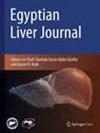A case of Osler-Weber-Rendu syndrome, diagnosed at geriatric age, presenting with gastrointestinal bleeding, telangiectasias, and asymptomatic liver and lung angiodysplasia
IF 0.7
Q4 GASTROENTEROLOGY & HEPATOLOGY
引用次数: 0
Abstract
Osler-Weber-Rendu syndrome (OWRS) is an autosomal dominant disease with recurrent epistaxis, mucocutaneous telangiectasias, and arteriovenous malformations. Its clinical presentation ranges from simple skin lesions to life-threatening complications. When the diagnosis of the disease is delayed, it can be mortal and have high morbidity. This case is presented because OWRS is rare, and although she has all the features of the disease, she was diagnosed in the geriatric age group. A 72-year-old female patient who applied to the emergency department with the complaint of melena was diagnosed with upper gastrointestinal system bleeding. Gastroscopy revealed angiodysplasia in the bulb. Colonoscopy was normal. She had telangiectasias on her face, maxilla, nose, tongue and lips. She also had recurrent epistaxis and a family history. Thorax CT showed aneurysmatic vascular malformations in the lung. Abdominal MRI revealed vascular malformations in the liver. Brain MRI was normal. The patient was diagnosed with OWRS according to the Curaçao diagnostic criteria because of telangiectasia in the mouth, nose, and face, angiodysplasia in the gastric bulb, aneurysmatic vascular dilatation in the lung, vascular pathologies in the liver, and a history of epistaxis and telangiectasia in the patient’s family members. This patient is presented because OWRS is rare, and although she has all the features of the disease, she was diagnosed in the geriatric age group. Clinicians should be aware of this rare disease. Especially in the elderly, when angiodysplasia causing gastrointestinal bleeding is detected, it should be considered in the differential diagnosis that this may be an OWSR case.一例老年期确诊的奥斯勒-韦伯-伦杜综合征患者,表现为消化道出血、毛细血管扩张以及无症状的肝脏和肺血管增生症
奥斯勒-韦伯-伦杜综合征(OWRS)是一种常染色体显性遗传病,伴有反复鼻衄、粘膜毛细血管扩张和动静脉畸形。其临床表现从简单的皮肤损伤到危及生命的并发症不等。如果延误诊断,可能会导致死亡和高发病率。本病例的出现是因为 OWRS 非常罕见,虽然她具有该病的所有特征,但她被诊断时已是老年患者。一名 72 岁的女性患者因主诉有血便到急诊科就诊,被诊断为上消化道系统出血。胃镜检查发现球部血管增生。结肠镜检查正常。她的面部、上颌骨、鼻子、舌头和嘴唇上有毛细血管扩张。她还有反复鼻衄和家族病史。胸部 CT 显示肺部有动脉瘤状血管畸形。腹部核磁共振成像显示肝脏有血管畸形。脑部磁共振成像正常。根据库拉索诊断标准,该患者被诊断为 OWRS,因为其口腔、鼻腔和面部出现毛细血管扩张,胃泡出现血管增生,肺部出现动脉瘤状血管扩张,肝脏出现血管病变,而且患者的家庭成员有鼻衄和毛细血管扩张病史。本例患者的病因是 OWRS 非常罕见,虽然她具有该病的所有特征,但确诊时已是老年期。临床医生应该注意这种罕见疾病。特别是在老年人中,当发现血管增生症引起消化道出血时,应在鉴别诊断中考虑这可能是一个 OWSR 病例。
本文章由计算机程序翻译,如有差异,请以英文原文为准。
求助全文
约1分钟内获得全文
求助全文

 求助内容:
求助内容: 应助结果提醒方式:
应助结果提醒方式:


